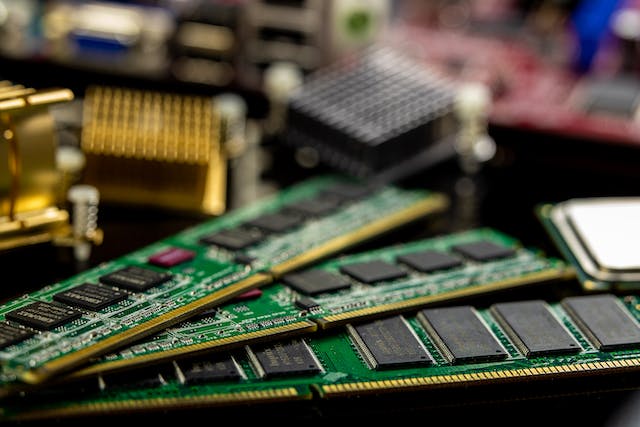RAM - What Is It and How to Increase It
Within the realm of laptops, a sophisticated ecosystem thrives, comprising an array of intricate components. Among these, the one that undeniably exerts a profound influence on overall functionality is the RAM. Here, we embark on a quest to fathom the essence of RAM, its sphere of influence, methods of augmentation, and the rationale behind expanding it. Permit me to elucidate.
The Vital Role of RAM
RAM, alternatively known as memory, RAM module, or simply module, commands a pivotal position within any laptop's architecture. It stands distinct from hard drives in that it doesn't serve as a repository for files. Instead, RAM assumes the role of harboring transient data required by applications or games. This dynamic storage capacity facilitates the concurrent execution of myriad tasks on a laptop, facilitating the simultaneous operation of multiple browser tabs and the launch of numerous programs. As the device shoulders an increasing workload, its demand for RAM proportionately escalates.
Expanding RAM: A Primer
The prospect of augmenting available RAM isn't a simple task of enhancement. Primarily, it necessitates the acquisition of a fresh RAM module, destined for integration into the motherboard. While most computers and laptops offer the liberty to undertake this operation independently, exceptions persist. Notably, contemporary Apple laptops embrace a design wherein the RAM is soldered onto the motherboard, rendering expansion implausible.
DDR4 vs. DDR3 RAM
Two predominant categories of RAM prevail - DDR4 and DDR3. These represent the most prevalent modules celebrated for their heightened operational speeds in contrast to their predecessors, DDR and DDR2. Before embarking on a RAM upgrade, the prudent approach entails identifying the RAM variant compatible with your computer, given that DDR4 and DDR3 RAM aren't interchangeable.
Effacing RAM Clutter
Periodically, when an excessive array of applications runs concurrently, the laptop may manifest signs of lethargy and diminished efficiency. Some applications fall short in effacing the data residing in RAM, progressively congesting its memory. In such scenarios, a simple reboot of the device typically alleviates the situation. It is, however, imperative to avert future scenarios where the laptop's entire RAM capacity becomes fully occupied, as this can usher in operational disruptions.
Selecting RAM for Your Laptop
Navigating the realm of computer technology requires foresight, as obsolescence looms relentlessly. Therefore, if fiscal constraints permit, embracing hardware configurations poised for the future is recommended. Consequently, opting for systems anchored by DIMM modules adhering to the DDR4 standard emerges as an astute choice. Yet, instances where a laptop primarily serves as a hub for office applications and web browsing, with budget constraints governing component procurement, DDR3-based systems can suffice.
For most contemporary applications, 8-16GB of RAM proves adequate. For optimal performance, selecting a pair of identical 8GB modules for installation is advisable. However, if tasks include intensive graphics handling, considerations for expanding memory warrant attention. Notably, 32-bit systems support a maximum of 3GB of memory, and Windows 7 x64 can harness up to 16GB. Harmonizing memory frequency with the motherboard and processor's capabilities remains pivotal, with most systems comfortably accommodating frequencies ranging from 1600 to 2133 MHz.
Verifying RAM Specifications
Unsure about your laptop's RAM configuration? Discerning it is remarkably straightforward. Commence with basic information accessible via a right-click on "This PC" and selecting "Properties." Alternatively, delve into the Control Panel and access "System." These routes divulge fundamental details about your laptop, though they might omit DDR technology specifics. As of today, DDR4 RAM stands as the prevailing standard, yet vestiges of DDR3 endure. Thus, ascertaining your RAM's classification merits attention. Utilizing free software like CPU-Z offers precision in discerning each facet of your computer's configuration. If uncertainty persists regarding DDR technology, querying your motherboard model online can yield the requisite clarity.
For a swift assessment of RAM volume, press CTRL + ALT + DEL, invoking the Task Manager. Within the "Performance" tab, RAM details unfold.
Modern Standards and Frequencies
When embarking on a new laptop acquisition or initiating the assembly of a home system, DDR4 memory modules beckon as the preferred choice. Presently, DDR4 memory reigns supreme, boasting the highest peak data transfer rate. Furthermore, DDR4 memory modules operate at a supply voltage of 1.2 V, a notable reduction from the 1.5/1.65 V embraced by the preceding DDR3 standard. This diminished power consumption, by approximately 20-30%, augments their appeal. In addition, DDR4 modules extend the envelope by accommodating more capacious memory chips, theoretically culminating in maximum module capacities soaring up to 128 GB.
In contrast, DDR3 modules occupy a rung lower in bandwidth compared to DDR4 memory. They chiefly function to invigorate prior-generation systems, contingent on the presence of a robust motherboard and processor capable of accommodating modules adhering to this standard. As an identifying feature, DDR4 and DDR3 memory modules distinguish themselves through pin count, with DDR4 encompassing 288 pins and DDR3 sporting 240. These modules aren't intercompatible, offering a safeguard against inadvertent interchanges through differences in slot positioning.
Frequencies and Their Implications
The clock frequencies of RAM modules have incrementally scaled with the advent of each succeeding generation. Presently, DDR4 memory oscillates within the bandwidth of 2133-3200 MHz. This breadth of modules harmonizes harmoniously with a broad spectrum of contemporary processors. DDR3 modules, on the other hand, cap their frequencies at 1866 MHz, occasionally venturing into 2133 MHz territory. It's vital to bear in mind that augmenting memory frequency doesn't necessarily usher in a substantial surge in overall system performance. Nonetheless, applications predisposed to direct memory access and graphic-intensive tasks yield favorable outcomes from faster memory.
For configurations leveraging CPUs equipped with dual-channel memory controllers, a symmetrical installation of memory modules is imperative to harness the full spectrum of memory-processor communication potential. Some CPUs bestow the privilege of a four-channel controller, necessitating the installation of four memory modules to unlock the four-channel mode. In this scenario, modules must adhere to identical parameters, timings, and frequencies to ensure seamless compatibility.

